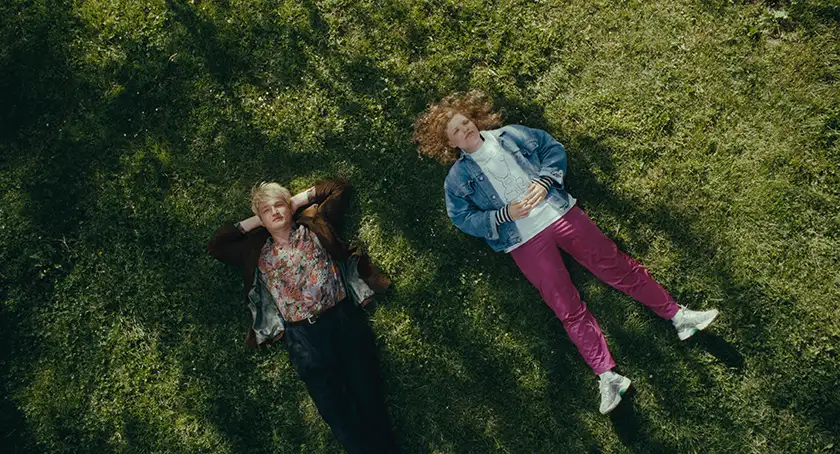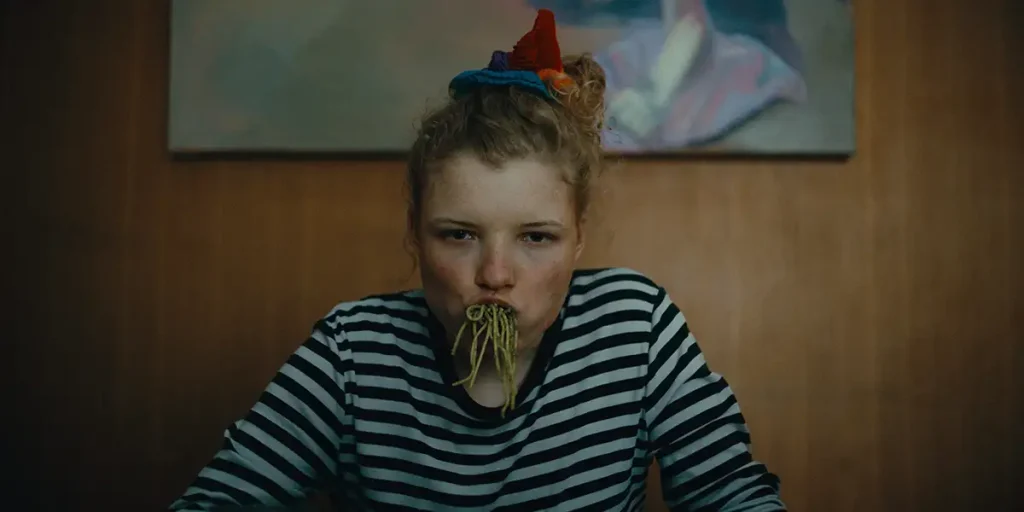Florian Pochlatko’s How to Be Normal and the Oddness of the Other World has a strong artistic vision that is let down by the film’s lackluster substance.
Writer & Director: Florian Pochlatko
Genre: Drama
Run Time: 102′
Berlin Film Festival Screening: February 16, 2025
Release Date: TBA
How would you define normal? Would you base normalcy on a blanket standard of societal expectations of behavior? Or would you base normalcy on a person-to-person basis of their typical behavior? What happens if those two standards of measurement differ completely? Florian Pochlatko’s debut feature, How to Be Normal and the Oddness of the Other World, shows its protagonist in a desperate pursuit of normalcy in the highly abnormal modern world.
How to Be Normal follows Pia (Luisa-Céline Gaffron), a 26-year-old who has just been released from a psychiatric hospital to the care of her parents. As Pia re-enters the world, she feels a palpable staleness. It’s as if this world were old, yet she is new and uncertain about how to navigate this old life of hers. All she wants is to be normal once again, but as she reflects on her life before entering the psychiatric hospital, she doubts the sense of normalcy she longs to return to has ever existed.
While she has been in the hospital, her parents, her friends and the world she once knew have begun to implode. She is given a job at her father Klaus’ (Cornelius Obonya) company, which has always been his pride and joy, only to quickly find out the company is majorly struggling and her father doesn’t have the resources or ability to save it. She is desperate to reconnect with her ex Joni (Felix Pöchhacker), but he is unable to allow her back into his life after the unforeseen events that led to her hospitalization. Worst yet, he has a new, “normal” girlfriend. Piled with medication to try and help her reach equilibrium, Pia feels less and less like herself and struggles to find a way to return to who she used to be.
How to Be Normal had enormous potential. Pochlatko’s artistic vision is precise and exacting. He shoots Luisa-Céline Gaffron as Pia with a tenderness that makes it abundantly clear how much he cares for this character. Within this film, he takes risks with alternating aspect ratios and experimental storytelling that make this feature truly unique.

However, the substance of the plot does not match the ambition of the way Pia’s story is told. It’s clear that the goal of Pochlatko’s storytelling is to put audiences in Pia’s shoes, trying to make the film’s atmosphere feel unstable and scenes feel untruthful to imitate what it is like to live in Pia’s mind. The constant doubt and instability of the world around her are meant to explain to audiences the motivations behind Pia’s actions.
If putting us in Pia’s shoes had been the film’s sole ambition, it would have been a success. However, when you look at the movie stripped away from its technical elements, it leaves much to be desired. The commentary on normalcy in modern society is surface-level at its best and half-baked at its worst. While Pia is initially obsessed with the concept of being her old self, this seemingly central plot point is never resolved and she descends further and further into madness.
This becomes a theme within How to Be Normal. The film poses questions about the universe, humanity and individualism but doesn’t attempt to meaningfully answer them. There is a huge push to make the audience come to their own conclusions, perhaps to say these questions can never be answered. But these questions about identity and human nature are central to the movie’s plot, and leaving their answers open to interpretation makes the film’s conclusion feel lackluster and lazy rather than introspective and profound.
There is a constant desire for context in How to Be Normal, references to Pia’s past you think will eventually be unveiled, or burning questions you believe will be answered. Yet, the film is only concerned with showing audiences Pia’s present, even though this actively works against Pia and the audience’s ability to connect and empathize with her.
It becomes apparent that the mental instability she was sent away for was never cured, but beyond knowing she is struggling with reality, there is nothing that makes you feel a particularly strong allegiance to Pia. While she can’t help her actions that actively hurt those who care about her, robbing the audience of the context surrounding why she is the way she is leaves us unable to see her as complex but rather difficult and destructive.
There are glimpses of greatness within How to Be Normal and the Oddness of the Other World; however, the artistic vision of this film overwhelms its minuscule character and substance development. While its visual depiction of the struggles Pia has with her mental health are impactful, the film doesn’t stand to make a particularly substantial commentary on mental health in the modern world.
How to Be Normal and the Oddness of the Other World: Movie Plot & Recap
Synopsis:
26-year-old Pia is placed in her parent’s care after being discharged from a psychiatric hospital. As Pia re-enters the world, she struggles with a new job, a painful heartbreak and a plethora of medication that make her feel further and further from the person she was before entering the hospital. She begins a relentless search to find her sense of normalcy in a world that seems to be imploding around her.
Pros:
- A director with a clear visual style
- Experimental storytelling
Cons:
- Lack of actual substance
- Leaves audiences with more questions than answers
How to Be Normal and the Oddness of the Other World premiered at the Berlin Film Festival on February 16, 2025. Read our Berlin Film Festival reviews and our list of 20 films to watch at the 2025 Berlin Film Festival!

